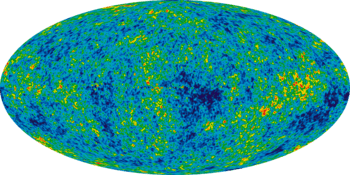Peryton (astronomy)
In radio astronomy perytons are short radio signals having a duration of a few milliseconds, detected only by the 64-meter Parkes radio telescope in Australia since 1998.[1][2] They are named after the Peryton, a mythical creature by novelist Jorge Luis Borges.
Perytons were found to be the result of premature opening of microwave oven doors at the Parkes Observatory.
Outdated hypotheses
These signals mimic some aspects of fast radio bursts (FRB) that appear to be coming from outside the Milky Way galaxy,[3][4] but their astronomical origin was soon excluded.[5][6][7] Hypothesized potential sources of perytons included:[8][9]
- Signals from aircraft
- Flashes in the ionosphere
- Lightning
- Solar flares
- Terrestrial gamma-ray bursts
- Narrow bipolar pulse. (These are electrical discharges between clouds at high altitude with a capacity of several hundred gigawatts.)
Identification
In 2015, perytons were found to be the result of premature opening of microwave oven doors at the Parkes Observatory. The microwave oven releases a frequency-swept radio pulse that mimics an FRB as the magnetron turns off.[2][10]
References
- ↑ Hall, S. (May 12, 2015). "Microwave Ovens Spark Radio Signals". Sky & Telescope. Retrieved 2015-12-25.
The reason dates back 17 years, when astronomers first spotted fleeting bursts of radio signals in their data.
- 1 2 Gilster, P. (April 6, 2015). "Puzzling Out the Perytons". Centauri Dreams. Retrieved 2015-12-25.
- ↑ Burke-Spolaor, S.; Bailes, M.; Ekers, R.; Macquart, J.-P.; Crawford III, F. (2011). "Radio Bursts with Extragalactic Spectral Characteristics Show Terrestrial Origins". The Astrophysical Journal. 727 (1): 18. arXiv:1009.5392
 . Bibcode:2011ApJ...727...18B. doi:10.1088/0004-637X/727/1/18.
. Bibcode:2011ApJ...727...18B. doi:10.1088/0004-637X/727/1/18. - ↑ Bagchi, M.; Nieves, A. Cortes; McLaughlin, M. (2012). "A search for dispersed radio bursts in archival Parkes Multibeam Pulsar Survey data". Monthly Notices of the Royal Astronomical Society. 425 (4): 2501–2506. arXiv:1207.2992
 . Bibcode:2012MNRAS.425.2501B. doi:10.1111/j.1365-2966.2012.21708.x.
. Bibcode:2012MNRAS.425.2501B. doi:10.1111/j.1365-2966.2012.21708.x. - ↑ Saint-Hilaire, P.; Benz, A. O.; Monstein, C. (2014). "Short-duration Radio Bursts with Apparent Extragalactic Dispersion". The Astrophysical Journal. 795 (1): 19. arXiv:1402.0664
 . Bibcode:2014ApJ...795...19S. doi:10.1088/0004-637X/795/1/19.
. Bibcode:2014ApJ...795...19S. doi:10.1088/0004-637X/795/1/19. - ↑ Katz, J. I. (2014). "What Perytons are not, and Might Be". The Astrophysical Journal. 788 (1): 34. arXiv:1403.0637
 . Bibcode:2014ApJ...788...34K. doi:10.1088/0004-637X/788/1/34.
. Bibcode:2014ApJ...788...34K. doi:10.1088/0004-637X/788/1/34. - ↑ Kulkarni, S. R.; Ofek, E. O.; Neill, J. D.; Zheng, Z.; Juric, M. (2014). "Giant Sparks at Cosmological Distances?". The Astrophysical Journal. 797 (1): 70. arXiv:1402.4766
 . Bibcode:2014ApJ...797...70K. doi:10.1088/0004-637X/797/1/70.
. Bibcode:2014ApJ...797...70K. doi:10.1088/0004-637X/797/1/70. - ↑ Bushwick, S. (April 22, 2015). "Mysterious Radio Bursts Are Indeed Coming From A Galaxy Far, Far Away". Popular Science. Retrieved 2016-05-05.
- ↑ Danish Khan, M. (2014). "Perytons and their Possible Sources". arXiv:1404.5080
 [astro-ph.HE].
[astro-ph.HE]. - ↑ Petroff, E.; Keane, E. F.; Barr, E. D.; Reynolds, J. E.; Sarkissian, J.; Edwards, P. G.; Stevens, J.; Brem, C.; Jameson, A.; Burke-Spolaor, S.; Johnston, S.; Bhat, N. D. R.; Kudale, P. C. S.; Bhandari, S. (2015). "Identifying the source of perytons at the Parkes radio telescope". Monthly Notices of the Royal Astronomical Society. 451 (4): 3933–3940. arXiv:1504.02165
 . Bibcode:2015MNRAS.451.3933P. doi:10.1093/mnras/stv1242.
. Bibcode:2015MNRAS.451.3933P. doi:10.1093/mnras/stv1242.
External links
- What is a peryton? At Physics SE
